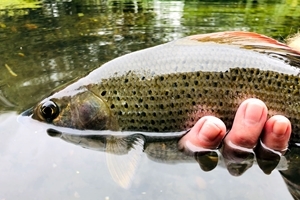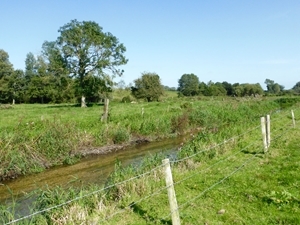Summary
- Grayling numbers fell by over 75% in all age-classes over this study (2003-2019).
- Low river flow in summer was linked to reduced adult survival, and lower flow in winter was linked to reduced juvenile survival.
- More days of higher summer temperatures, and more cover with river plants were both associated with reduced survival of some age-classes.
- These conditions are becoming more common on the Wylye river, and the impacts they have on grayling may be a warning for the future of other species.
- We are grateful to The Grayling Research Trust, The Piscatorial Society and Wessex Water for funding this study.
Background
 Grayling are a less widely known member of the salmon family of freshwater fish. Known as the ‘lady of the stream’, they have a large, sometimes colourful dorsal fin and are primarily found in fast-flowing, clean rivers. Grayling have a lower tolerance for pollution than trout or salmon, so their presence can be an indicator of good water quality.
Grayling are a less widely known member of the salmon family of freshwater fish. Known as the ‘lady of the stream’, they have a large, sometimes colourful dorsal fin and are primarily found in fast-flowing, clean rivers. Grayling have a lower tolerance for pollution than trout or salmon, so their presence can be an indicator of good water quality.
Although they used to be thought a competitor for trout and were sometimes removed to prevent them impacting populations on trout fishing rivers, a greater understanding has shown that grayling and trout can occupy different niches and grayling presence does not negatively affect trout. Grayling are themselves thought of as a good sporting fish to anglers and are valued by fishermen in their own right.
However, some grayling populations have been declining in recent decades, and they are vulnerable to changes in temperature, river flow, water quality, etc. As with many fish species, grayling have several different life stages from egg to mature adult. Individuals in these different stages and at different ages move from one habitat to another and have different age-specific requirements. This means that the species overall needs good conditions in multiple different habitats and locations, and that at different ages of fish might be susceptible to different changes. Very few studies have tried to tease out the impact of environmental changes on the variously aged fish within a species. The River Wylye in Wiltshire is towards the edge of the range where grayling are naturally found, and this study looked at the impacts of many factors on survival of fish of between one and five years old.
What they did
 The scientists studied many age-classes of grayling in the River Wylye. This included juvenile fish (less than one year old), one-year-old subadults, and mature adults aged two to five years. They monitored grayling survival in these ages from 2003-2019, and gathered additional data for many other variables including:
The scientists studied many age-classes of grayling in the River Wylye. This included juvenile fish (less than one year old), one-year-old subadults, and mature adults aged two to five years. They monitored grayling survival in these ages from 2003-2019, and gathered additional data for many other variables including:
- River flow
- Air temperature (as a proxy for water temperature)
- Food abundance
- River plant cover
- Abundance of older trout at the site
The scientists then looked for associations between grayling survival at different ages, and changes in these factors.
What they found
Overall, grayling numbers fell by over 75% in all age classes throughout the study. This was mostly driven by a loss of mature adult fish.
Changing river flows were particularly bad for grayling survival, with different effects on the different ages. More days of lower flow in winter were linked to the reduced success of juvenile fish surviving from eggs. More days of very low flow in summer (where amount of water flowing in the river on a given day was in the lowest 10% of days seen) was linked to lower survival for both subadult and mature adult fish.
More days of high air temperatures in summer also had a negative influence relating to lower survival for juveniles. Survival of juveniles and subadults was also affected by the amount of aquatic plant cover in the river – with more cover being associated with poorer survival.
What does this mean?
More extreme environmental conditions seem to be becoming more frequent on the River Wylye, with the number of days of very low flow in summer, lower flow in winter and high air temperatures in summer being above average in the past few years. The impact of this appears to have been detrimental to grayling survival, with numbers falling to less than a quarter of what was recorded in 2003, and negative effects of the changing conditions on all the different life stages for this fish.
The Wylye is located towards the southern edge of the grayling’s range, and these changing conditions that are more challenging for the species may affect grayling populations that are located further north as the climate changes in the future. Also, as the grayling is more sensitive to temperature changes than others in the salmonid family, it can give an early warning of what the future might hold for related species.
A better understanding of the particular aspects which can affect the different vulnerable life stages of this species can help conservationists design strategies to help protect them.
Read the original paper
Marsh, J.E., Cove, R.J., Britton, J.R., Wellard, R.G., House, A & Gregory, S.D. (2021). Medium-term environmental changes influence age-specific survival estimates in a salmonid population. Freshwater Biology.